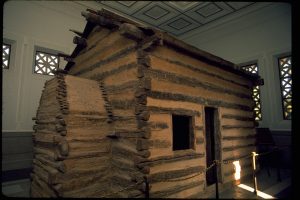In 1808, Thomas and Nancy Lincoln moved into Sinking Spring Farm. In 1809, Abraham Lincoln was born inside a log cabin located there. Today, the cabin shows the address of 2995 Lincoln Farm Road, Hodgenville, Kentucky. Although Lincoln’s father would move his family to a nearby farm two years later, the cabin on Sinking Spring farm never lost its appeal to historians and history lovers.
When Lincoln became the president of the United States in 1860, the public began to have a deep interest in the birthplace cabin. The interest intensified even more after Lincon’s assassination in 1865. Three decades after Lincoln’s death, numerous artists created paintings and drawings of the cabin and their own interpretations of the scene surrounding Lincoln’s birth.
In 1927, a booklet entitled “The Lincoln Log Cabin” was published by the Lincoln scholar Dr. Louis A. Warren. In it, he asserted the authenticity of the log cabin’s structure. Warren states that many important historical articles are linked to Abraham Lincoln but that nothing is more valuable than the cabin itself, where Lincoln was born. However, the National Park Service historian, Richard Sellars, contradicted the contents of Warren’s booklet. He says that the search for the cabin was driven by a mixed desire for profit and knowledge, complicated by the mixing up of Confederate relics.
The most widely-held view among historians is that the original log cabin had been taken apart many years before 1865. However, some local people believed that some of the logs that made up the cabin were re-used in another cabin that was built close by. As a result, the businessman, A.W. Dennett, bought the Sinking Springs Farm, including the house that was built nearby. Believing that the house was built with some of the original logs, Dennett had it disassembled and used its logs to “rebuild” Lincoln’s birthplace cabin. However, people did not flock to see the rebuilt Lincoln cabin, so Dennett had it taken apart and showed it in different parts of the country. At some point, he showed the alleged Lincoln cabin with another cabin that he claimed was Jefferson Davis’ boyhood house. Unfortunately for Dennett, the logs from the two cabins became intermixed in one storage space.
A few years later, the Lincoln Farm Association rebuilt Lincoln’s cabin using the intermixed logs, even though both sets of logs were most probably not authentic. The association positioned the rebuilt cabin near Hodgenville, Kentucky, inside a marble and granite memorial building. An inscription was placed at the entrance to the memorial edifice, which read, “Here over the log cabin where Abraham Lincoln was born, destined to preserve the Union and free the slave, a grateful people have dedicated this memorial to unity, peace, and brotherhood among the states.”
However, even in the few years after Lincoln’s death, the birthplace cabin’s existence had already been disputed. The first important remark about its questionable existence came from Robert Todd Lincoln, son of Abraham Lincoln. In a 1919 letter, Robert plainly said that the original cabin had already decayed years before his father even became president. He added that anyone who claimed that the cabin inside the marble memorial was the real one was committing fraud.
Despite persistent doubts about the authenticity of the logs, the rebuilt cabin retained its allure, at least to some people. In 1909, President Theodore Roosevelt placed the cornerstone of the memorial building. On that day, he said that the log cabin symbolizes the link between Lincoln and ordinary people and that the cabin now means to the American people what the Bethlehem stable means for Christians. Roosevelt added that while Christians placed the holy birthplace inside the Church of the Nativity, Americans placed the birthplace cabin inside a marble temple. The marble temple was completed in 1911, but the space containing the cabin was too small for visitors to walk around in. Instead of enlarging the space, the architect shrank the cabin from its original size of 16 by 18 feet to 12 by 17 feet.
In 1911, President William Howard Taft dedicated the building’s completion. In 1916, the federal government took charge of the site, and in 1933, the site was turned over to the care of the National Park Service.
In 1948, the National Park Service conducted an investigation into the authenticity of the logs. The investigation turned up powerful evidence suggesting that the logs were not authentic. In 1991, another investigation published the same results.
The final blow came in 2004 when a study of the tree rings of the logs exposed that the logs had been cut in 1848 — 39 years after Lincoln was born.
Today, the site has a bookstore and a theater. However, the reassembled birthplace cabin stands only as a symbol of the original one.
